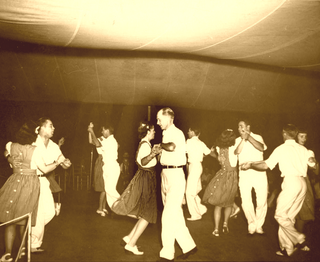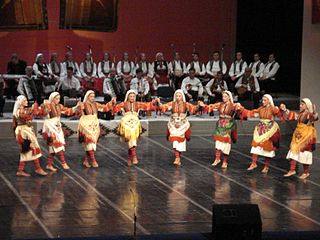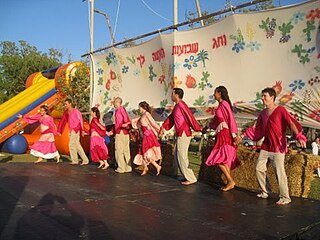
Contra dance is a form of folk dancing made up of long lines of couples. It has mixed origins from English country dance, Scottish country dance, and French dance styles in the 17th century. Sometimes described as New England folk dance or Appalachian folk dance, contra dances can be found around the world, but are most common in the United States, Canada, and other Anglophone countries.

Regency dance is the term for historical dances of the period ranging roughly from 1790 to 1825. Some feel that the popular use of the term "Regency dance" is not technically correct, as the actual English Regency lasted only from 1811 until 1820. However, the term "Regency" has been used to refer to a much broader period than the historical Regency for a very long time, particularly in areas such as the history of art and architecture, literature, and clothing. This is because there are consistencies of style over this period which make having a single term useful.

A country dance is any of a very large number of social dances of a type that originated in the British Isles; it is the repeated execution of a predefined sequence of figures, carefully designed to fit a fixed length of music, performed by a group of people, usually in couples, in one or more sets. The figures involve interaction with your partner and/or with other dancers, usually with a progression so that you dance with everyone in your set. It is common in modern times to have a "caller" who teaches the dance and then calls the figures as you dance.

A square dance is a dance for four couples arranged in a square, with one couple on each side, facing the middle of the square. Square dances contain elements from numerous traditional dances and were first documented in 16th-century England, but they were also quite common in France and throughout Europe. Early square dances, particularly English country dances and French quadrilles, traveled to North America with the European settlers and developed significantly there.

Irish Dance refers to a group of traditional dance forms originating from Ireland, encompassing dancing both solo and in groups, and dancing for social, competitive, and performance purposes. Irish dance in its current form developed from various influences such as earlier native Irish dance, English country dancing and later possibly French quadrilles, as it became popular in Britain and Ireland during the 19th Century. Dance was taught by "travelling dance masters" across Ireland in the 17th-18th century, and separate dance forms developed according to regional practice and differing purposes. Irish dance became a significant part of Irish culture, particularly for Irish nationalist movements. From the early 20th century, a number of organisations promoted and codified the various forms of dance, creating competitive structures and standardised styles. Irish dancers who compete for competitive reasons dance in a dance style that's more modern than traditional Irish dance. It is mainly done solo, but there is some team dancing in groups of 2, 3, 4, 6, 8, 10, 16 and even numbers on wards. Competitive Irish dancers wear dresses heavily crystalled in Swarvoski and beam on stage. Competitive Irish dancers may also wear large wigs and stage makeup.

Scottish country dance (SCD) is the distinctively Scottish form of country dance, itself a form of social dance involving groups of couples of dancers tracing progressive patterns. A dance consists of a sequence of figures. These dances are set to musical forms which come from the Gaelic tradition of Highland Scotland, as do the steps used in performing the dances. Traditionally a figure corresponds to an eight-bar phrase of music.

Klezmer is an instrumental musical tradition of the Ashkenazi Jews of Central and Eastern Europe. The essential elements of the tradition include dance tunes, ritual melodies, and virtuosic improvisations played for listening; these would have been played at weddings and other social functions. The musical genre incorporated elements of many other musical genres including Ottoman music, Baroque music, German and Slavic folk dances, and religious Jewish music. As the music arrived in the United States, it lost some of its traditional ritual elements and adopted elements of American big band and popular music. Among the European-born klezmers who popularized the genre in the United States in the 1910s and 1920s were Dave Tarras and Naftule Brandwein; they were followed by American-born musicians such as Max Epstein, Sid Beckerman and Ray Musiker.

Hora, also known as horo and oro, is a type of circle dance originating in the Balkans but also found in other countries. Hora retains the Romanian name as it was widespread and known in the world.

The quadrille is a dance that was fashionable in late 18th- and 19th-century Europe and its colonies. The quadrille consists of a chain of four to six contredanses. Latterly the quadrille was frequently danced to a medley of opera melodies.
Irish set dance, sometimes called "country sets", is a popular form of folk dancing in Ireland.
The music of Grenada has included the work of several major musicians, including Eddie Bullen, David Emmanuel, one of the best-selling reggae performers ever, and Mighty Sparrow, a calypsonian. The island is also known for jazz, most notably including Eddie Bullen, a pianist, songwriter and record producer currently residing in Canada. Kingsley Etienne, a keyboardist, while the Grenadan-American Joe Country & the Islanders have made a name in country music.

Israeli folk dance is a form of dance usually performed to songs in Hebrew, or to other songs which have been popular in Israel, with dances choreographed for specific songs. Israeli dances include circle, partner and line dances. As almost all dances are intentionally choreographed, and the choreographers are known and attributed, the reference to these dances as "folk dances" is sometimes controversial among the general folk dance community. The recent trend of dances becoming much more complex and "professional" has led some to use the alternative term "Recreational Israeli Dancing".
Traditional square dance is a generic American term for any style of American square dance other than modern Western. The term can mean (1) any of the American regional styles that existed before around 1950, when modern Western style began to develop out of a blend of those regional styles, or (2) any style that has survived, or been revived, since around 1950.

Jewish dance is dance associated with Jews and Judaism. Dance has long been used by Jews as a medium for the expression of joy and other communal emotions. Dancing is a favorite pastime and plays a role in religious observance.

The cotillion is a social dance, popular in 18th-century Europe and America. Originally for four couples in square formation, it was a courtly version of an English country dance, the forerunner of the quadrille and, in the United States, the square dance. In American usage, a Cotillion is a formal ball, often the venue for presenting Debutantes. The cotillion is a formal social dance that began in the early 18th century Europe by French royalty. Later it became popular in England among families of nobility and white families in the United States of great wealth, especially in the South. In the early 20th century, some affluent black families adapted the tradition.
Bush dance is a style of dance from Australia, particularly where the music is provided by a bush band. The dances are mainly based on the traditional folk dances of the UK, Ireland and central Europe.
Jewish music is the music and melodies of the Jewish people. There exist both traditions of religious music, as sung at the synagogue and domestic prayers, and of secular music, such as klezmer. While some elements of Jewish music may originate in biblical times, differences of rhythm and sound can be found among later Jewish communities that have been musically influenced by location. In the nineteenth century, religious reform led to composition of ecclesiastic music in the styles of classical music. At the same period, academics began to treat the topic in the light of ethnomusicology. Edward Seroussi has written, "What is known as 'Jewish music' today is thus the result of complex historical processes". A number of modern Jewish composers have been aware of and influenced by the different traditions of Jewish music.

Michael Alpert is a klezmer musician and Yiddish singer, songwriter, multi-instrumentalist, scholar and educator who has been called a key figure in the klezmer revitalization of the 1970s and 1980s. He has played in a number of groups since that time, including The An-Sky Ensemble, Brave Old World, Khevrisa, Kapelye, The Brothers Nazaroff and Voices of Ashkenaz, and collaborated with clarinetist David Krakauer, hip-hop artist Socalled, singer/songwriter Daniel Kahn and bandurist Julian Kytasty. Alpert is also a pioneering teacher and researcher of Yiddish traditional dance and has been central to restoring Yiddish dance to its time-honored place alongside klezmer music as a key component of East European Jewish expressive culture. He is the recipient of a 2015 National Heritage Fellowship awarded by the National Endowment for the Arts, the United States government's highest lifetime honor to its folk and traditional artists. Alpert continues to perform and teach worldwide from his home in Scotland.
Moisei Iakovlevich Beregovsky (1892–1961) was a Soviet Jewish folklorist and ethnomusicologist from Ukraine, who published mainly in Russian and Yiddish. He has been called the "foremost ethnomusicologist of Eastern European Jewry". His research and life's work included the collection, transcription and analysis of the melodies, texts and culture of Yiddish folk song, wordless melodies (nigunim), East European Jewish instrumental music for both dancing and listening, Purim plays, and exploration of the relationship between East European Jewish and Ukrainian traditional music.
KlezKanada is a Canadian organization for the promotion of klezmer music and Yiddish culture. Its principal program is a week-long Jewish music festival founded in 1996 that takes place annually in August at Camp B'nai B'rith in Lantier, Quebec. The organization also hosts workshops, concerts, and other educational programs in Montreal throughout the year.












